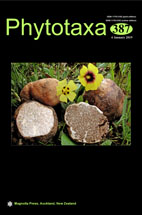Abstract
In its current circumscription, Senecio ser. Culcitium Cabrera, which includes ca. 40 South American species, is characterized by discoid, sometimes nodding capitula, calycular bracts resembling a multiseriate involucre, and style branches apically truncate with a ring of penicillate collecting hairs. The phylogenetic relationships of Senecio ser. Culcitium were examined based on DNA sequences from ITS and trnK regions, focusing on seven endemic species of Argentina and Chile never included in previous works. Likewise, 18 morphological characters were analyzed and mapped on the phylogeny in order to discuss their importance in defining the group. Our results confirm the polyphyly of S. ser. Culcitium as circumscribed by Cabrera because its members appeared in four different clades throughout Senecio. One clade contains the taxonomic type of the series and about a half of the species previously assigned to S. ser. Culcitium. Most of the Argentinean-Chilean endemic species are split into three different clades distantly related to the principal Culcitium clade: 1) Senecio candidans and S. gilliesii are nested within S. ser. Hualtatini; 2) S. aspleniifolius and S. jarae are nested within S. ser. Repentes; and 3) S. diemii, S. magellanicus, and S. martinensis appear within the informally named ‘diemii group’. The nodding capitulum, which was traditionally used as a diagnostic character for Culcitium, could be used to define morphologically S. ser. Culcitium in its revised circumscription. However, the other two characters traditionally used as diagnostic, i.e. development of calycular bracts and pubescence of style branches, are variable within the series: the calycular bracts range from scarcely to widely developed and the pubescence of the style branches ranges from a few short hairs poorly differentiated into a crown of hairs to numerous long hairs. As a result of the morphological study of the characters and the phylogenetic analysis, we include a key to differentiate S. ser. Culcitium s. str. from the other series and the informal diemii group, in which the Culcitium species have been redistributed.

